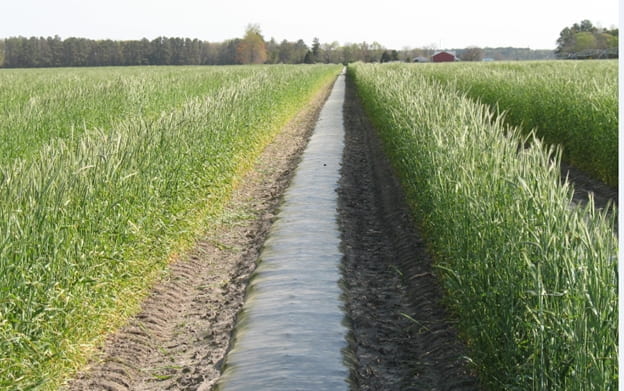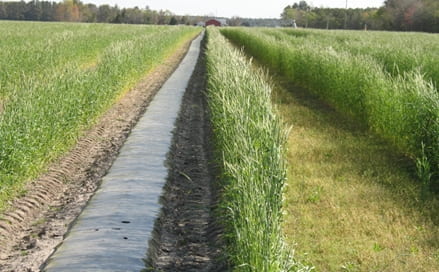Gordon Johnson, Extension Vegetable & Fruit Specialist; gcjohn@udel.edu
We are seeing great benefits with the use of high-quality windbreaks in vegetables in 2022.
Windbreaks are a very useful tool for producing early vegetables. Most commonly, rye is used because it grows taller than other small grains and elongates in April. Using rye windbreaks requires planning because they are planted the previous fall (September-October).
Windbreaks can be planted between every vegetable bed, every 2-3 beds, or in drive row areas only. For early protection, every-bed windbreaks are recommended. Most commonly a drill is used and 2-4, 7” drill rows of rye are planted, and the other drill spouts are blocked off to leave the area where the vegetable crop will grow (bed areas) unplanted. As an alternative, the field can be solid planted and areas between windbreaks can be tilled in early spring to terminate the rye in bed areas. Windbreaks can be use in bare ground systems but are most effective when combined with plasticulture
Windbreaks serve several functions:
- Windbreaks block high winds, thus protecting transplants and seedlings from direct wind damage (whipping, tearing, shredding, and breaking stems and leaves).
- Windbreaks reduce or eliminate “sandblasting” in sandy soils where fine sand particles are picked up by the wind. Sandblasting can severely damage young plants by shredding leaves and cutting stems.
- Windbreaks reduce transpiration losses in young transplants thus reducing losses to wilting and desiccation.
- Windbreaks reduce convectional heat losses from the soil, thus providing a warmer environment for early growth.
- Windbreaks can serve as a mulch between plastic beds, reducing soil contact for vining crops such as melons, thus producing cleaner fruit and reducing the potential for soil borne diseases infecting fruits.
Rye is the most common crop used for windbreaks because of its early growth and height. Triticale (wheat/rye cross) matures 1-2 weeks later and can be used as a windbreak. Barley is also early; however, modern varieties are shorter in stature and less effective as a windbreak. Wheat is later still and not as effective as rye for early plantings.

Plastic mulch bed between every-bed-planted rye windbreak that is full height. This will provide maximum protection and heat accumulation.
In no-till or strip till systems using rye cover crops or mixtures with rye, windbreaks can be left in the field by rolling some areas and leaving others unrolled as a windbreak.
Windbreak growth termination is also important. All rye (or other small grain) windbreaks should be killed using a non-selective herbicide before viable seed is produced, otherwise volunteer grain will come up in later crops. This is not a big problem for farms that only produce vegetables but can be a major issue on farms that rotate with other crops (volunteer rye in a wheat field for grain is a problem).

Rye windbreak with drive row area for pesticide application and harvesting.
